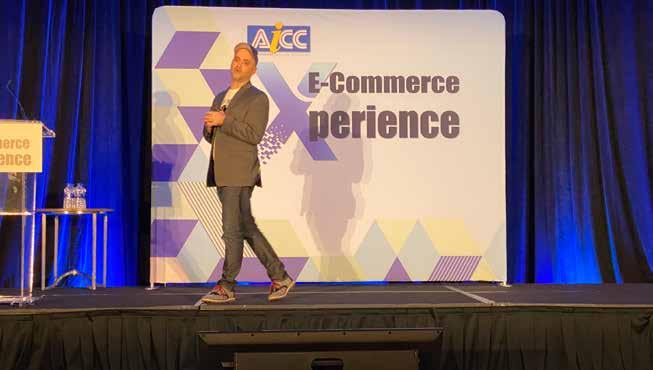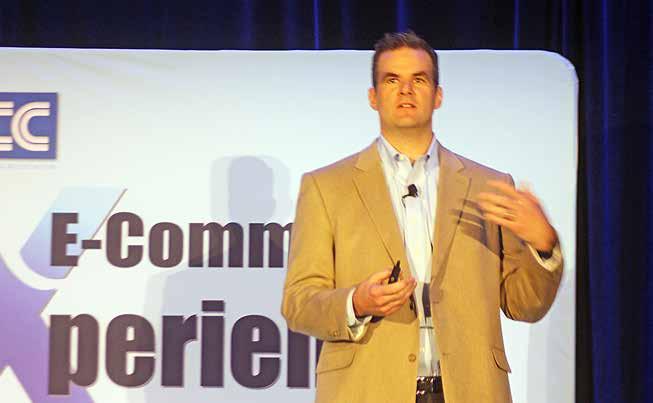
9 minute read
Opportunities and Challenges for Corrugated in the E-Commerce Economy
from May/June 2020 BoxScore: VR and AR Technologies Hold Untapped Potential for Boxmakers and Clients
BY STEVE YOUNG
AICC’s E-Commerce Xperience, which took place February 18–20 in Irving, Texas, brought together brand owners, packaging designers, converters, and suppliers for a comprehensive look at the e-commerce economy and how it will affect the corrugated industry. More than 150 AICC members and industry experts attended.
Advertisement
E-Commerce: an Opportunity for Corrugated
The sessions opened by offering a view of the total e-commerce economy and an outlook for its growth in the years ahead. Ron Sasine, a principal in the consulting firm of Hudson Windsor LLP, presented a positive picture of a corrugated industry that, although 2019 saw its growth slacken from the previous three years, will continue to benefit from the growth in online retail sales. The caveat, he said, was that this benefit will be reserved for those companies in the industry with the “best assets and best operations.”
Every year, online sales capture a greater percentage of the $3.8 trillion U.S. retail sales market. According to Statista, in 2013, 6% of all retail sales were online; in 2019 the figure was 11%, or $546 billion, and by 2023 it is forecast to be nearly 14%, or $740 billion. Sasine reported that the e-commerce sales of major consumer packaged goods, or CPG, companies are growing at five times the rate of conventional retail sales and are expected to double by 2024.
Sasine predicted that online grocery sales would be a major driver in the demand for corrugated packaging. He made the case for this by showing how buying a book four times a year online from Amazon will result in the use of four five-panel corrugated folders. On the other hand, online grocery purchases made through Amazon’s Pantry unit or from retailers such as Walmart or Target require several boxes every week for 52 weeks. Grocery items, Sasine said, are “bulky, inexpensive, and low-margin” and are not suitable to Amazon’s ship-in-own-container (SIOC) guidelines. As a result, Sasine predicted that as e-commerce sales grow, consumption of corrugated packaging will increase.
‘The Future of Amazon’ Disclosed
Brent Lindberg, CEO of Fuseneo, gave an insightful presentation on “The Future of Amazon.” Fuseneo’s focus is to help clients improve their packaging, minimize unnecessary material consumption, and thereby better conform to the new rigors of the online sales platforms.
Amazon, the largest digitally native online sales platform, last year captured upward of 47% of all those online sales; its closest competitor, eBay, trailed at 6%. Because Amazon dominates this market, it exerts the lion’s share of influence in setting new packaging guidelines for brands wishing to sell through its platform. These standards, also known as “frustration-free packaging,” include new requirements on design and ease of use, both for the online fulfillment and distribution system and for the end-use customer. Lindberg explained that Amazon’s standards look at packaging in three tiers; all three tiers consider the level of handling that must be done in
Spring Meeting Supplier Innovations are located at aiccbox.org/SI2020
Ron Sasine of Hudson Windsor presented “The Future of Corrugated: Everything Depends on It” at AICC’s E-Commerce Xperience.
Amazon’s distribution centers and on the customer’s doorstep. Tier one requires that packaging products arriving at the customer’s door be curbside-recyclable where those programs exist. The second tier requires vendor products to SIOC (ship in own container). Neither tier one nor tier two requires any additional packaging modification, or “overboxing,” by Amazon. Tier three products require some sort of preparation or overboxing to prevent damage or to allow oddsized items to ship more easily through the distribution system, and Amazon currently charges vendors up to $1.99 per
Brent Lindberg of Fuseneo presented an overview of Amazon’s changing packaging requirements for products sold through their platform.

item for products that must be prepped for shipping in this way.
Lindberg told the AICC audience that Amazon is putting increasing pressure on brands to conform to Amazon’s packaging protocols by requiring International Safe Transit Association-6 (ISTA-6) SIOC test certification for items shipping in their own container. For those items requiring additional product preparation, brands are simply paying the per-item penalty. “They consider paying the Amazon penalties a cost of doing business,” Lindberg said, adding that it’s more difficult to retool their own packaging lines to meet the Amazon standards than it is to pay the penalties.
In the final analysis, Amazon is a data company, employing internal Amazon Serial Identification Numbers, or ASINs, to track every item through its fulfillment and distribution hubs. Through this data collection, the company is fine-tuning its packaging guidelines to ensure smoother flow through its automatic sorting and labeling lines. Through a series of illustrations, Lindberg showed how Amazon determines whether an item meets overboxing or SIOC requirements by using dimensions and product weight.
Amazon’s stated goal to become carbon neutral by 2030 means it continues to refine its packaging and shipping methods, utilizing lighter-weight flexible mailers and padded envelopes. While these moves will reduce the company’s corrugated consumption for many items, Lindberg said, corrugated packaging will continue to make up the largest portion of materials used in Amazon shipping. To blunt public criticism of “the box that’s too big,” Lindberg said, some brands are using the box as a way to “delight the customer.” He pointed to examples of brands that have used graphics to suggest that the box has utility beyond a shipping medium—a yoga mat or a child’s toy, for example—to shift consumer perception.
A Brand’s Perspective: What’s the E-Commerce Packaging Sweet Spot?
Jared Butts is senior manager of e-commerce supply chain for The Hershey Company. Butts’ presentation, “Understanding Packaging in E-Commerce Process,” focused on how major brands such as The Hershey Company view the various channels through which their product is sold, from retail to e-commerce platforms, and how the differing characteristics of these channels affect their packaging decisions. Butts first defined e-commerce, saying that “e-commerce is the conversion of sales on online platforms,” distinguishing it from simply “digital,” meaning sales through online platforms, or “omnichannel,” meaning sales through direct and third-party online platforms and traditional retail stores. He further defined e-commerce as “an integral piece of the digital and omnichannel experience.”
Major consumer brands such as Hershey’s Kisses rely on such
Jared Butts of The Hershey Company was one of several major brand owners talking about their packaging challenges in the e-commerce economy.

omnichannel sales, Butts said. The company has: its own website, hersheys. com, a business-to-consumer site; retail platforms in traditional retailers such as Target, Walmart, and Kroger; and thirdparty digitally native platforms such as Amazon and Candy.com. To meet packaging requirements of the major brands selling across e-commerce platforms, Butts set out four basic principles to govern e-commerce packaging: 1. Design: Keeping it simple, as most manufacturers are concerned first with cost. 2. Dimensions: Optimizing dimensions saves cost through the distribution and fulfillment system. 3. Dunnage: Don’t use plastic fill or foam peanuts, as the interim user may be in a fulfillment or distribution center. 4. Disposal: Is it easy for the consumer to break down and recycle?
Ultimately, Butts said, it’s important for suppliers of packaging to end users whose products are being sold through e-commerce channels to understand the product—is it premium or not?—to understand the channel through which it’s sold, and to understand the nature of the distribution and fulfillment environment—whether the item requires special handling on the part of the e-commerce platform.
Understand the Stakeholders in Your Customer’s E-Commerce World
Joe Fernandez is the senior packaging engineer for handbag maker Vera Bradley. In this capacity, he manages the brand’s catalog of e-commerce and retail packaging, which deals with movement of the company’s goods in all stages of manufacturing and distribution. In his presentation to the E-Commerce Xperience audience, he addressed the packaging challenges brands face and the kinds of design solutions that will appeal to internal stakeholders.
According to Fernandez, there are three principal stakeholders in major brands such as Vera Bradley: procurement, operations, and marketing. He described the procurement department as the “bridge to other stakeholders.” While they are primarily cost-driven, they also are the receiving point for the stated needs of operations and marketing departments. As a result, Fernandez said, bringing cost-savings solutions—ones that reduce packaging materials or weight or can consolidate the number of various designs—is the best approach.
A brand’s operations department is the next stakeholder that packaging manufacturers need to reach. He focused on the new norms of online buying, such as two-day shipping and the rise of highly automated distribution centers. These new norms present opportunities for
well-designed packaging to “save seconds” in the fulfillment of each order. He also said that user-friendly box designs are important to workers in distribution and fulfillment centers. “A happy employee is part of your solution,” he said.
Finally, he touched on the brand’s marketing department and spelled out what keeps them up at night. First, “What do customers think of our brand?” Second, “Is our design consistent?” And third, “How do we communicate the sustainability of our brand?” In answering these questions, Fernandez said that packaging that fits the brand in terms of shape, color, and quality are the principal design solutions that brands will look for. He said that social media presented special challenges in the rise of so-called “unboxing” videos in which brands are highlighted.
Fernandez caused a bit of controversy among the attendees at the E-Commerce Xperience by saying that Vera Bradley had done away with much of graphics associated with their e-commerce packaging, adding that the product itself is the focal point and that the company found no change in consumer buying habits when it reduced graphics and shipped the product in a plain box. After a spirited exchange on this question, he allowed that they may be open in the future to considering a change.
AICC’s E-Commerce Xperience is part of AICC’s annual “Xperience” series, which focuses on industry-specific issues and trends. Watch for more articles from AICC’s E-Commerce Xperience and other Xperience events in future issues of BoxScore.
Steve Young is AICC’s ambassador-at-large. He can be reached at 202-297-0583 or syoung@ aiccbox.org.
Joe Fernandez of Vera Bradley told AICC’s audience that graphics are not a priority in their e-commerce packaging.

AICC’s E-Commerce Xperience featured many more speakers and topics than those highlighted in this article. We will feature some of these in future editions of BoxScore and as new developments emerge in the e-commerce economy. Thanks to the following members and guest speakers: • Miriam Brafman, Packlane • Richard Brown, The Boxmaker • Abby Byland, Dusobox • Paul Chambers, Subscription
Trade Association • Lauren Frisch, Wasatch Container and
Box Essentials • Jesse Genet, Lumi • R. Andrew Hurley, Ph.D.,
Clemson University • Lawrence Ingrassia, Henry Holt & Co. • Paul Jarrett, Bulu Box • Richard Kelley, Dusobox • Liz Logue, EFI • Mark Mathes, Vanguard Packaging • Sarah Meiburg, Paper &
Packaging Board • Tania Montesi, H.B. Fuller • Michael Pelletier, Scaling
Operations LLC • George Perreira, Whitebird • Olivia Pietersen, The Packaging Co. • Stephen Shannon, HP • Robert Stabler, Koenig & Bauer Durst
We are grateful to our sponsors & supporters: • Koenig & Bauer | Durst • Poteet Printing Systems • HP • Tilia Labs • Huston Patterson • American Carton Company • Harris Packaging • SUBTA, Subscription Trade Association









